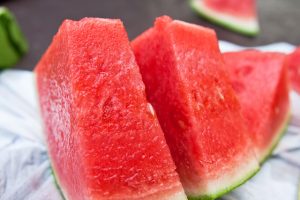Nature’s Nutritious Treat: Watermelon
 Watermelon, a member of the cucumber, squash, and pumpkin family, is nearly 92 percent water, but the leftover eight percent is both sweet and nutritious.
Watermelon, a member of the cucumber, squash, and pumpkin family, is nearly 92 percent water, but the leftover eight percent is both sweet and nutritious.
It is the substantial fructose (sugar) content of watermelon that makes it seem like nature’s version of cotton candy, and why it should be eaten in moderation. The sugar intake can also be balanced by consuming watermelon with a good source of protein.
Watermelon Nutrition Benefits
Watermelon is the perfect hot weather treat since its high water content helps us stay hydrated. As is quenches our thirst, it also provides these valuable nutrients.
Vitamins C, A, B6. A serving of watermelon provides a fifth of our daily recommended value of vitamin C—necessary for a strong immune system. It gives us nearly that percentage of the vitamin A so important for our eye’s health. Watermelon is also a vitamin B6 source, something our body must have to break down the proteins we consume.
Lycopene The star nutrient in watermelon is the antioxidant lycopene. It is what gives pink watermelon its rosy color. Along with neutralizing free-radicals, lycopene is protective and nourishing to our skin and heart. It diminishes tissue inflammation and may strengthen our bones.
Other Benefits Research suggests that watermelon relaxes our blood vessels, improves arterial function and helps lower blood pressure. Watermelon also contains enough potassium to help balance our cell’s fluids, and provides some magnesium.
Choosing A Ripe Watermelon
To get the most nutritional benefit from watermelon you will want to pick a ripe one, so look for:
- a pale buttery-yellow spot on the bottom, where the melon sat on the ground.
- a melon that is heavy for its size.
- a smooth rind (surface) that is dull on top (the top being opposite the yellow ground spot).
- a hollow low sound when you thump the melon (may or may not be a sign of ripeness, depends who you ask).
Did you know the black seeds and white rind of the watermelon are edible and nutritious? To enjoy the rind, pop it in a blender with some lime. The rind is a rich source of the amino acid l-citruline that is reported to relieve muscle soreness. The seeds contain zinc, iron, protein, and fiber.
Watermelon Salsa Recipe
Ingredients and procedure:
3 cups finely diced seedless watermelon
2 jalapeno pepper, seeded and minced
1/3 cup chopped cilantro (about 1/2 bunch)
1/4 cup lime juice
1/4 cup red onion, minced
1/4 teaspoon salt – or to taste
Put all the ingredients but salt in a medium bowl and stir to combine. Season with salt and serve chilled or at room temperature.
Sources: Food Facts; mercola.com
Photo credit: Steven Depolo / flickr
 Eating Disorder Self Test. Take the EAT-26 self test to see if you might have eating disorder symptoms that might require professional evaluation. All answers are confidential.
Eating Disorder Self Test. Take the EAT-26 self test to see if you might have eating disorder symptoms that might require professional evaluation. All answers are confidential.